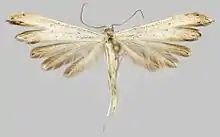Hellinsia tephradactyla
Hellinsia tephradactyla (also known as the plain plume) is a moth of the family Pterophoridae found in most of Europe (except Iceland, the Iberian Peninsula, Ukraine and Croatia).[1] It was first described by the German taxonomist Jacob Hübner in 1813.
| Hellinsia tephradactyla | |
|---|---|
 | |
| Scientific classification | |
| Kingdom: | Animalia |
| Phylum: | Arthropoda |
| Class: | Insecta |
| Order: | Lepidoptera |
| Family: | Pterophoridae |
| Genus: | Hellinsia |
| Species: | H. tephradactyla |
| Binomial name | |
| Hellinsia tephradactyla (Hübner, 1813) | |
| Synonyms | |
| |
The wingspan is 18–23 millimetres (0.71–0.91 in). Adults are on wing in July.[2]
Larvae of the plain plume feed on European goldenrod (Solidago virgaurea), false aster (Aster bellidiastrum) and common daisy (Bellis perennis). Feeding is either on the flowers and seed heads or on the underside of leaves, depending on the source.[2][3]
References
- "Hellinsia tephradactyla (Hübner, 1813)". Fauna Europaea. Retrieved 18 March 2010.
- Kimber, Ian. "Hellinsia tephradactyla (Hübner, [1813])". UKmoths. Retrieved 6 August 2020.
- Ellis, W N. "Hellinsia tephradactyla (Hübner,1813) plain plume". Plant Parasites of Europe. Retrieved 6 August 2020.
This article is issued from Wikipedia. The text is licensed under Creative Commons - Attribution - Sharealike. Additional terms may apply for the media files.